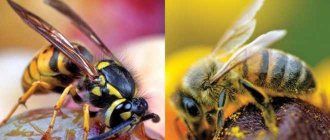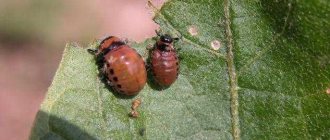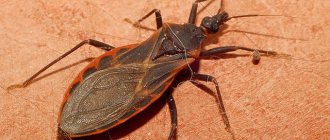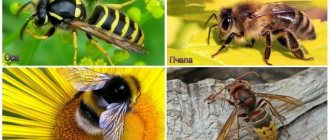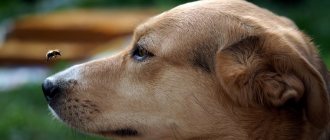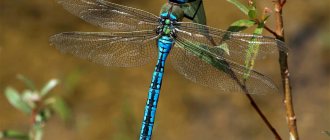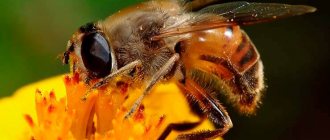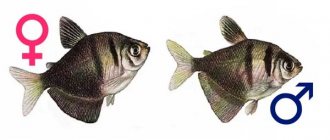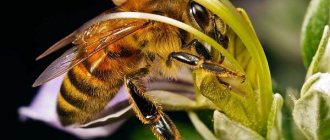The insect photo clearly demonstrates the differences between a bee and a wasp; city residents need to carefully study them before going out into nature. Both insects sting painfully, and their bites can cause allergic reactions. It is worth knowing their habits, the places where they can be found most often, in order to protect yourself and your children from attack. In addition, both species differ in varying degrees of aggressiveness.
External differences
First of all, these insects differ in color. In the wasp it is brighter: rich yellow stripes alternate with black. The bee's body color is more subdued. She has stripes of honey and black. Also, the color of the bee, unlike the wasp, looks blurred due to the villi, and the abdomen has a more rounded shape. The hairiness of the insect contributes to the performance of one of the main functions - pollinating plants.
The body of a wasp, unlike a bee, is more slender, elongated, with clear contours and a smooth surface. Its body is divided into two parts by a narrow bridge, separating the thoracic and abdominal sections.
Distinguish a wasp from a bee upon careful examination, since it does not have baskets on its feet, necessary for collecting nectar. It is also larger in size.
External differences
Body structure
The body of a wasp consists of a head, torso, legs and wings.
The eyes have a special structure - they consist of a large number of plates - facets, this makes it possible to see simultaneously in all directions. The eyes are bulging and protrude above the head.
But besides these eyes, wasps have three more eyes, located at the top of their heads. It’s hard to believe that a wasp is so big-eyed, but you can easily be convinced of this by examining the wasp’s head in a close-up photo.
Multifunctional antennae grow on the head - they are needed for smell and touch, the wasp uses them to detect air movement, and they also work as taste buds.
The wasp’s antennae are also a device for measuring cells when building a nest.
Only females have a sting - in females it plays the role of an ovipositor, and in case of danger, the insect uses it as a weapon - releasing poison through it into the body of its enemy.
Lifestyle
There is also a difference between a bee and a wasp in their lifestyle. In nature, honey insects live in trees or rock crevices in honeycomb nests. The inside of their home is covered with wax.
Bees live in colonies that include a queen, workers and drones. Each of them performs its specific function. The queen breeds offspring, workers extract nectar and process it into honey, and drones inseminate the female and regulate the temperature inside the nest.
Unlike bees, the wasp prefers to settle in gardens, as well as near human habitation. These insects build nests under the roofs of houses and various buildings. They make their homes from chewed wood and grass. Wasps can be solitary or social, living in a family like bees.
Differences in flight
If you compare a wasp, a bee, a bumblebee during the flight, you can also find significant differences.
Wasps make sudden movements and easily hover in the air. In an instant they can move from one place to another. During long-term observation, one can notice constant jerking movements and frequent changes in trajectory.
Bees fly more calmly and measuredly. They do not make sudden movements and try to land quickly. They do not create an annoying buzzing sound; it is more difficult to notice them by their sound than wasps.
On a note!
Experts have long called the flight of a bumblebee an exception to the rules of aerodynamics. The furry specimen flies smoothly and slowly, creating a rather noticeable roar.
Behavior
Bees are quite friendly insects. But if their hive is in danger, they all come to its defense. There is a certain hierarchy in the family of these honey insects. The highest level in it is assigned to the uterus. All the other inhabitants of the hive care about her well-being.
The difference in behavior between wasps and bees is that the former are quite aggressive. Being predators by nature, they are able to attack at any moment, using not only the sting, but also, in the case of other insects, the jaw apparatus. The queen of social wasps takes care of itself independently. She spends the winter alone without assistants or guards. During this period, she reproduces larvae and arranges a nest.
When to seek help from doctors
You should immediately call an ambulance if:
Diet
Bees eat purely plant foods. The basis of their diet is nectar, pollen, and honey. Therefore, they can mainly be found circling near flowering crops, as well as near water.
Wasps are also able to feed on nectar. But the difference is that their diet also includes spoiled fermented fruits, vegetables, and food waste. Being predators, they are able to hunt other insects, including bees. Wasps will not refuse to feast on the carrion of birds and various animals.
Nectar source
What do they eat?
The feeding habits of insects also differ. Bees feed their larvae pollen and nectar. Adults also eat the same food. At the same time, wasps are considered predators and use protein products to feed the larvae. Most often they use caterpillars or other insects for this purpose. Wasps also feed on fruit and vegetable juice, flower nectar, food waste, and carrion.
Features of the sting
These insects also differ in the shape of their sting. In a bee, it resembles a tiny harpoon, as it has serrations. When attacking, the bee's sting pierces the upper layer of a person's skin and poison is injected through a thin channel inside it. When trying to pull it back out, part of the insect's intestine is torn off. Therefore, after a sting, a bee dies within a few minutes to 3 days.
The wasp's sting is smoother, sharper, and has no jagged edges, so after attacking its opponent, it can easily reach it and, if necessary, repeat the attack several times in a row.
How does a bee sting?
The bee sting process occurs in several stages:
- The insect comes into contact with the surface of the enemy's skin. Under the influence of the abdominal muscles, the tip of the sting, hidden in the abdomen, is directed to the exit hole.
- The bee's stinger extends outward and the insect plunges it into the skin of the victim.
- When the tool sinks at least a third, the bee can no longer pull it out; the notches interfere with this. After the insect stings, it tries to fly away, resulting in part of the abdomen being torn off.
Despite the fact that the bee has already flown away, the poison continues to enter the stung person’s body for some time through the sting remaining in the skin.
Nature of the bites
A wasp and a bee sting painfully, but the former's poison is more toxic, and therefore the human body's reaction to it is instantaneous. Redness and swelling of the bite site appears almost immediately. The wasp's feeding on sewage also contributes to this, as a result of which an infection can get into the wound. This leads to a more pronounced inflammatory process, which may be accompanied by suppuration.
When a bee stings, in most cases the site of injury retains its normal color, and after the sting is removed, the skin quickly recovers.
It is impossible to say objectively who stings more painfully, a bee or a wasp, since each person has a different sensation of pain. But American entomologist Justin Schmidt, during a special experiment, discovered some peculiarity. According to him, a wasp sting can be compared to burning the tip of the tongue with a cigarette, and a bee sting can be compared to burning the skin with an open fire. But since the sting of the honey insect has serrations, the pain lasts longer.
Folk remedies
Symptoms disappear completely within a week. All this time the sore spot hurts and itches. To speed up tissue regeneration, folk remedies are used. They are also used if it is not possible to treat the wound with professional antiseptics.
On a note!
The juices of potatoes, carrots, beets, lemon, and grapefruit have anti-inflammatory properties. They make compresses, lotions, and simply wipe the wound.
Benefits and harms of bees and wasps
When comparing bees and wasps in terms of benefits for humans, we can definitely say that the former were more successful in this. They produce honey, wax, bee bread, royal jelly, and zabrus. All of these products are natural antibiotics. Unlike pharmaceuticals, they are able to have a selective effect, that is, suppress the development of only harmful microflora.
Honey
Bee venom also has healing properties, and dead insects are also used in medicine. Based on them, a special tincture is prepared, which helps in the treatment of joints and the genitourinary system.
Bees also bring great benefits to nature. The lives of flowering plants and these insects are closely related. Bees, obtaining nectar, pollinate them, which contributes to the formation of fruits and seeds. Thanks to the bees, the size of the harvest increases.
Bees can harm a person only in case of danger that threatens their hive. In this case, all insects attack the enemy. To avoid this, do not go close to the hive without a protective suit.
Most wasp species do not produce honey, but they are not averse to eating it. Many people consider them to be completely useless insects, but this is not true. Wasps play an important role in nature. They are predators and therefore control the number of pests such as aphids, mole crickets, borers, caterpillars, beetles, and cicadas. These insects also contribute to plant pollination, although to a lesser extent than bees.
Wasps also cause harm. They spoil crops of fruits and vegetables by making holes in them to extract juice. Since wasps also feed on rotten food scraps, they often live in garbage dumps. As a result, they are carriers of infections.
Certain blood types sting people more often
Those who smell good to mosquitoes and bumblebees are often stung. Mosquitoes are first attracted to components of human sweat. It's not just sweat, breath, or more specifically carbon dioxide that can attract mosquitoes to spy on their victims. Other odors that attract them are lactic acid, uric acid, body heat and ammonia.
This explains, for example, why athletes are more likely to be stung than other people, because they produce significantly more lactic acid during exercise. The composition of bacteria on the skin also plays an important role. Blood type 0 is the most popular according to tests by the Institute of Pest Control Technology.
Summarizing
If you compare in size whether a wasp or a bee is larger, the advantage is on the side of the wasps. A wasp or bee sting is more dangerous - the wasp also wins in the ranking, but only in terms of the strength of the painful sensations. Bee venom is more dangerous if the sting is not removed in a timely manner. Whoever is more aggressive wins the wasp family again. Representatives are distinguished by excessive aggressiveness, nervousness, and rush to attack with a slight wave of the hand in their direction.
Sources
- https://BezTarakanov.ru/nasekomye/osy/otlichie-os-ot-pchyol/
- https://DachaMechty.ru/pchelovodstvo/pchely/i-osa.html
- https://GdeKlop.ru/osy-i-pchely/raznitsa/
- https://combat-dez.ru/kak-otlichit-pchely-ot-osy-kto-iz-nih-prinosit-bolshe-polzy-chi-ykysy-opasnee/
- https://oozoo.ru/rybki/osa-i-pchela-razlichiya-i-shodstva-foto.html
- https://petnaobed.ru/nasekomye/chem-otlichaetsya-pchela-ot-osy/
- https://fermilon.ru/hozyajstvo/pchelovodstvo/chem-otlichaetsya-osa-ot-pchely.html
- https://apest.ru/osy/ob-osah/osa-i-pchela/
[collapse]
What function do they perform?
For humans, bees are a vital insect, capable of pollinating a third of the world's plant crops. Pollen transfer required:
- cucumbers;
- soy;
- kiwi;
- citrus;
- pumpkin;
- melon;
- cotton;
- coffee tree, etc.
In addition, alfalfa and clover used in livestock feeding depend on bees for their life cycle. Representatives of the family provide the production of wax, propolis and royal jelly. The British Beekeepers' Association has calculated the contribution of bees to the global economy. The work they do on the major plant species used for human food alone is equivalent to €130 billion. The amount does not include the production of honey and related products.
Bees also influence the biological diversity of ecosystems. The transfer of pollen on body hairs provides genetic diversity in plants. Phytocenoses cultivated by bees are capable of self-sustaining without human intervention.
Due to the aggressive nature of wasps, their functions are limited to the destruction of pests, including mole crickets, and indirect protection of weak insects (imitation of the striped colors of harmless species).
The peptide toxin mastoparan contained in wasp venom is capable of destroying living cells and tissues. The scientific community is trying to develop an analog synthetic substance that selectively affects cancer cells.
